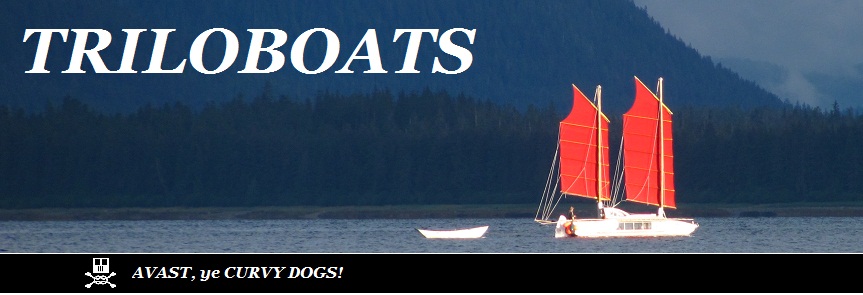 |
| Go forth and conquer! |
The days like flowers bloom and fade
and do not come again.
From (We've Only Got) These Times We're Living In by Kate Wolf
Climbing the Learning Curve
Everything in life has a learning curve... some stretches are but a gentle slope with decent footing; others steeper and can be slippery; yet others appear precipitous as we squint ahead. Some may indeed be insurmountable, but there are many paths.
I often write of TriloBoats (simple box barges) as being 'dumbed down' to basics. In many ways, they are. They are as simple as a hull can be.
But there is always a learning curve.
Decisions among the many options are best made when informed. Some minimal competence with tools is required - a low bar, to be sure, but it must be surmounted. Safety practices understood and made habitual.
And the hull is but a fraction of the finished vessel.
Interiors, rig and gear are at least somewhat independent of the hull. That is, these three would represent a more or less constant amount of effort, regardless of the hull in which they are being mounted. Together, they comprise a significant proportion of the learning curve/effort that goes into the finished vessel.
This is why I harp on KISS (Keep It Simple, Sailor) throughout, aloft and alow. At least for those of us who are looking for a short, easy-ish stroll through the foothills on the way to the water.
Once launched, comes sailing.
This, too, is a relatively easy, short stretch. There's just not much to the mechanics of sailing. Put sails up or down, trim and adjust them for on or off the wind. Balance the forces. Go.
Ah, but seamanship!
Here is Mount Analog, that summitless, ideal mountain, envisioned by Rene Daumal. The ways of wind and water. The ways of your vessel. Navigation, pilotage, the lay of your grounds, with its every rock in reach of your keel. The ways of your own heart, mind and soul.
We will never master our subject, but we can embrace the learning curve.
The journey is thrilling, and satisfying to the soul. Novelty abounds, and challenge never bleeds out to pale boredom. Strength, understanding and ability increase at every step. Even our mistakes extend our grasp!
Our world, at last, is far greater than ourselves, and our finite selves cannot exhaust it.
Not so our lives. This finite lot of time we call our own hastens to its end. These gifts of mortality are perishable.
Sailors!
Let us launch ourselves from our armchairs! Let us take up tool and material and bring to life these dreams of ours! If nothing else, let us build a punt and learn to sail it across a pond... take small, easy steps that teach us to stride with confidence. Let us risk sinking that we learn to swim!
For time is fleeting.
*****
[Favorite Scatological Imperative], or get off the pot!
- Folksy Advice
Full disclosure, here:
This winter is our 5th season caretaking, committing half a year at a crack. Okay work in beautiful places. But it ain't living aboard and at large.
Earnings let us build SLACKTIDE (who proves that box barges work as engineless cruisers), and rebuild our financial 'cushion'. It's paid for visits with family and a family emergency. It's pumping up our resources toward our next, last boat. Next winter, and maybe the next will rebuild our cushion to the point we may be able to coast through the rest of our lives.
That many half-years is a lot of time spent NOT cruising; not living the way we love.
It's a five year plan, which will have spread itself across a decade. A DECADE! And we're not getting any younger, nor our future more secure. Sure, we get a lot of sailing in-between gigs, but it's broken into by dead-line outfitting, and forced transits to and from work, clipping the wings of sailing free.
One has to ask, "How much of what's left of our time will the plan consume?" Is there time for our dream on its far shore?
Nothing is accomplished, without the plan. But neither does it get done with over-planning. Comes a point to every dream when its moment has come. The time is now. To leap while the iron yet burns. To take that first step, however small. To cast off and get underway.
For without that leap of faith, our dreams - and our lives lived without their realization - are but ashes to ashes, dust to dust.
*****
A case in point:
As WhiteSpotPirates, a woman is posting a weekly, video account of the pursuit of her dreams. White Spot is a literal translation of the German Weisser Fleck, the unexpored, 'blank space' on a chart.
In her series, Untie the Lines, she lets us tag along as she climbs the learning curve. It isn't all fun and games, but she's game, and on her way!

















